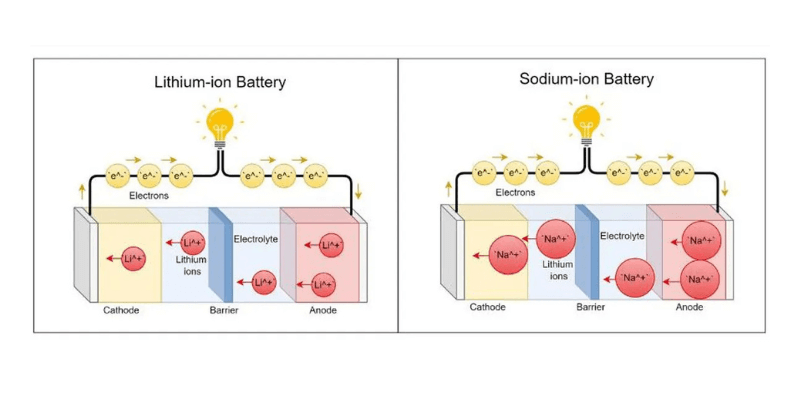Ko se svet preusmeri na nove energijske vire, se krepimo med natrijevim in litij-ionskim baterijam. Trenutno litij-ionske baterije vodijo na trg, vendar natrijeve-ionske baterije pridobivajo pozornost zaradi nekaterih privlačnih prednosti. Raziščite, kaj je vsaka edinstvena, njihove prednosti in slabosti ter njihove potencialne prihodnje usmeritve.
Kaj so natrij-ionske baterije?
Natrijeva-ionska baterija (SIB) je napolnjena baterija z uporabo natrijevih ionov (NA⁺) kot nosilcev naboja. Vsebuje katodo, ki vsebuje natrij, anodo in tekoči elektrolit. Med polnjenjem se natrijevi ioni ekstrahirajo in vstavijo v anodo, medtem ko se odvajanje pojavlja obratno.
Obstajajo različne vrste natrijevih-ionskih baterij, vključno z NAMNO2, NA3V2 (PO4) 2F3 in NA2FEFE (CN) 6.
NaMnO₂ (slojeviti oksid)
- Delovna napetost: 3,2 V; delovno območje: -40°C do 80°C.
- Življenjska doba cikla: do 4500 ciklov v laboratorijskih prototipih s strukturno optimizacijo (npr. dopiranje z borom).
- Izzivi: Hiter upad zmogljivosti (20 ciklov) zaradi faznih prehodov Mn³⁺; spremenjene različice izboljšajo stabilnost.
Na₃V₂(PO₄)₂F3 (NVPF, tip NASICON)
- Gostota energije: 75 Wh/kg pri stopnji 1C; visokonapetostni platoji pri 3,7 V in 4,2 V.
- Stabilnost cikla: Več kot 4000 ciklov v konfiguracijah s polnimi celicami zaradi prevlek iz ogljika in elektrolitskih dodatkov (npr. FEC).
- Uporaba: Primerno za shranjevanje v omrežju in električna vozila zaradi toplotne odpornosti in dolge življenjske dobe.
Na₂FeFe(CN)₆ (prusko bela)
- Učinkovitost: doseže 160 WH/kg energijske gostote s 3.000 cikli, če je seznanjen s trdimi ogljikovimi anodami; koristi od hitre difuzije NA⁺ v kubičnem okviru.
- Prednosti: Združljivost z nizko temperaturo (-20 ° C z 80% zadrževanjem zmogljivosti) in razširljiva sinteza, komercializirana s strani CATL.

Kaj so litij-ionske baterije?
Litij-ionske baterije so se z leti bistveno razvijale, prve pa so se razvile v 70. letih prejšnjega stoletja. Sestavljajo jih štiri glavne komponente: katoda, anoda, elektrolit in separator.
Katoda določa zmogljivost in napetost, anoda pa elektrone usmerja skozi žico. The elektrolit omogoča gibanje litijevih ionov med katodo in anodo za varen pretok električne energije. Materiali z visoko ionsko prevodnostjo olajšajo to gibanje, ki se razlikuje glede na vrsto elektrolita.
Obstaja šest glavnih tipov litijevih baterij; več informacij najdete tukaj.

Natrijeva ionska baterija proti litij-ionski bateriji
Pri primerjavi natrijevih in litij-ionskih baterij primerjalna tabela ponuja jasen vpogled v njihove razlike.
| Lastnosti | Natrijeva ionska baterija | Litij-ionska baterija |
| Razpoložljivost materiala | obilno | Omejena |
| Vpliv na okolje | Okolju prijazen | Manj okolju prijazen |
| Stroški | Poceni | visoko |
| Območje obratovanja | višje | visoko |
| Življenjski cikel | visoko | visoko |
| Gostota moči | Nizka | visoko |
| Čas polnjenja | Hitreje | hitro |

Izzivi za natrijevo ionsko baterijo
Proizvodnja natrijevih ionskih baterij se sooča z več izzivi, preden lahko nadomesti litij-ionske baterije.
- Ni vzpostavljene dobavne verige za materiale in malo podjetij je vključenih, kar povzroča višje stroške.
- Tehnologija se še razvija, kar omejuje prilagodljivost zasnove in ima za posledico manjšo gostoto in zmogljivost shranjevanja v primerjavi z litijevimi baterijami.
- Življenjska doba natrijevih ionskih baterij je 5000 ciklov, kar je bistveno manj kot 6000 ciklov komercialnih litij-železo-fosfatnih baterij.
Ali lahko baterije na osnovi natrija nadomestijo litij-ionske baterije?
Natrijeve ionske baterije bi lahko bile odlična alternativa litij-ionskim, vendar se soočajo z nekaterimi ovirami, preden lahko resnično vzletijo.
Da bi postali najboljša izbira za shranjevanje energije, morajo izboljšati svojo tehnično zmogljivost. Raziskovalci trdo delajo, da bi te baterije naredili bolj stabilne in cenovno dostopne, medtem ko so podjetja zaposlena z vzpostavljanjem trdne dobavne verige za potrebne materiale.

